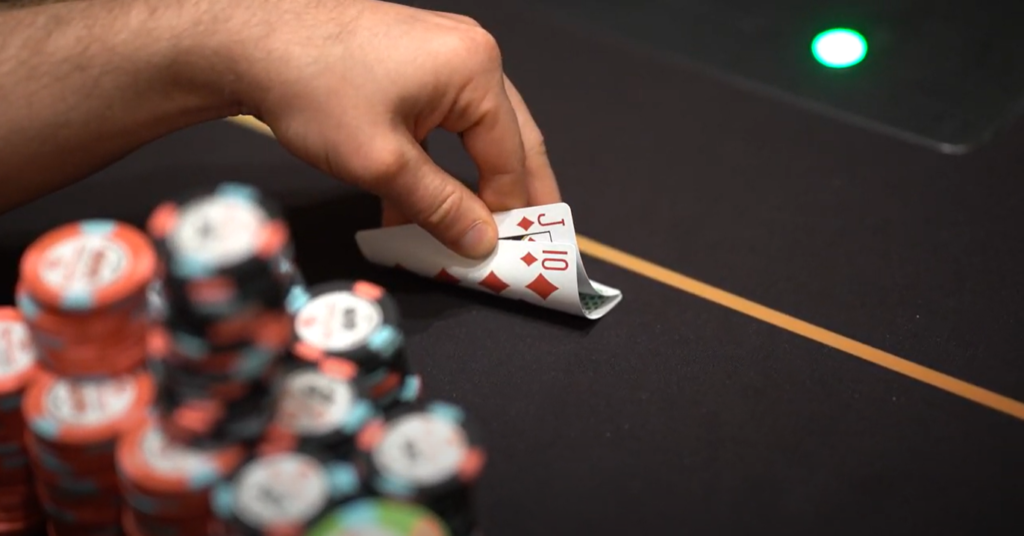The game revolves greatly around mathematics, and concepts you need to be good at differ from very simple to fairly advanced. Counting outs in poker is probably the simplest of them all.
It literally only requires the skill of counting, which most people should have down to perfection in their adulthood. While the skill itself is quite simple, we must first explain what poker outs are, how we count them, and what exactly we can use this knowledge for.
Let’s start by talking about the nature of outs in poker and when they come into play.
What Are Poker Outs?
In the simplest of terms, any card that can improve your hand into a stronger one is an out, whether it will give you a straight, flush, two pair, or even just one pair.
The value of different outs is not always the same, as some poker outs will give you the best possible hand while others may improve you to what is still a losing hand.
However, to get you started, we will talk about all poker outs, meaning all the cards that can improve your holding into a better one.
For example, imagine you have K♥Q♥, and the board runs J♥10♥4♦. In this situation, there are quite a few cards that can improve your hand.
Any non-heart Ace or a Nine will give you a Straight, which will be the nuts. Any heart will give you a Flush, with A♥ and 9♥ improving you to a Royal Flush and Straight Flush, respectively.
What’s even more, any of the remaining Queens or Kings in the deck will give you a pair, which alone could make the best hand, depending on your opponent’s holding.
So, now that we know what poker outs are, let’s learn how to count them.

Especially when holding hands like suited connectors, knowing how to count your outs is critical to making the correct decisions.
How to Count Outs in Poker
Now that you understand what poker outs are, it should be quite clear how we count them. The process consists of identifying what your outs are and then literally counting them out.
In the example above, we already identified the potential poker outs, so let’s count them out:
· Three Aces to make a Straight – 3
· Three Nines to make a Straight – 3
· A♥ and 9♥ to make a Royal/Straight Flush – 2
· Seven Hearts to make a Flush – 7
· Three Queens to make a Pair – 3
· Three Kings to make a Pair – 3
In total, this gives us 21 outs, which is about the most out you can have in the game of Texas Hold’em.
Granted, the Kings and Queens only give us one pair, which is not guaranteed to be the best hand, but most other outs will give us either the nuts or very close to it.
As you can see, the counting process is quite simple and really only requires you to be good at counting and visualizing what cards will improve your hand.
Keep in mind that there are exactly four cards of each rank in the deck and that there are exactly 13 cards of each suit in there.
What’s more, remember to account for the cards you are already seeing and not to double-count some outs. For instance, in our example above, if you count the A♥ and 9♥ as your Flush outs, don’t count them again as the Straight outs.
Common Out Counts in Poker
When it comes to counting outs, there are some very common scenarios in which this skill comes into play, and pro players know their outs count in these spots without even thinking about it.
You can know it too by simply memorizing this chart and remembering what each common draw means in terms of poker outs:
| DRAW | OUTS |
| Open-Ended Straight Flush Draw + 2 Overcards | 21 |
| Open Ended Straight Flush Draw + 1 Overcard | 18 |
| Open-Ended Straight Flush Draw | 15 |
| Gutshot Straight Flush Draw | 12 |
| Flush Draw + 2 Overcards | 15 |
| Flush Draw + 1 Overcard | 12 |
| Flush Draw | 9 |
| Open-Ended Straight Draw + 2 Overcards | 14 |
| Open-Ended Straight Draw + 1 Overcard | 11 |
| Open-Ended Straight Draw | 8 |
| Set to Full House/Quads | 7 |
| Two Pair to Full House | 4 |
| Two Overcards | 6 |
| One Overcard | 3 |
| Pocket Pair to Set | 2 |
In this table, we only counted the outs that give us at least a top pair or better, but there can be some scenarios in which outs to a lower pair could also be taken into consideration.
Furthermore, backdoor draws, such as three cards of the same suit or three cards to a Straight, can also be counted as partial outs, as they do add some EV to your hand.
Putting Poker Outs to Use In-Game – Calculate Your Equity
Knowing how to count outs in poker is only the first part of using this knowledge to actually come up with the likelihood your hand will improve on the following streets.
The number you are looking for is called “equity”, and it is the percentage of times you will hit one of your outs and improve your hand.
Equity is calculated by counting outs and finding the ratio of those outs to the remaining cards in the deck.
When the flop is dealt, for example, you can see five cards in total, which leaves 47 cards in the deck, any one of which could be your out.
If we assume you have 12 outs in a particular hand, your odds of hitting on the turn would be 12:47, which is just over 25%.
You should take into account the fact that two more cards will be dealt if you are calculating your equity on the flop, which means you have about 50% equity in this hand.
However, it is worth noting that these numbers do not represent your exact equity against a particular hand or range, as your opponent may also have cards that improve their hand.
In either case, this kind of calculation can give you a very close approximation of your true equity, which will be a couple of percentages up or down from this number.
Now, we are going to look into an even simpler way to calculate approximate hand equity without even having to figure out the ratios we just mentioned.
Rule of Two and Four in Poker – Quick Way to Calculate Poker Equity
While doing the full equity calculation mid-hand can be a bit tricky and daunting, as well as not very precise, there is another way of coming up with a similarly accurate equity number, using the rule of two and four.
The rule of two and four is as simple as it sounds. Doing simple multiplication will give you your approximate equity in just seconds.
All you need to do is multiply your number of outs by four if you are on the flop and by two if you are on the turn, and the number you get will be very close to your true equity.
For example, let us assume you have 10♠9♠ against A♣A♦ on a board of 7♠4♠2♥. You have a naked flush draw, which is good for 9 outs in total.
If you were to multiply that number by four gives you 36. According to the Hold’em Odds Calculator, your actual equity is 38.8%.
Now, if we assume the turn card is an irrelevant K♣, your real equity will turn to about 20%. Using the rule of two, the equity you would come up with is 18%, just slightly lower.
By using the rule of two and four and quickly multiplying your outs, you will be able to make quick estimations in play and avoid having to make any complex calculations that could lead to inaccurate numbers. Compare this is your pot odds, and you will know the right decision in any given hand.
While the equity you will come up with is not perfect, it will usually be close enough to tell you whether or not you have enough equity to proceed with your hand.
It is worth noting that as your number of outs increases, the rule of two and four will give more inaccurate numbers, which is why there is another simple formula you can learn to calculate your equity with a high number of outs.
Calculating Equity with Over 9 Outs
As your number of outs continues to increase, the numbers you get from applying the rule of two and four and your actual equity starts to diverge more and more.
For this reason, using the rule of two and four in situations where you have more than 9 outs can be a bit tricky, as the numbers produced are quite incorrect.
So, use this formula instead:
Equity = (Outs x 4) – (Outs – 8)
For example, let us think back to the example we used earlier, where we had 21 poker outs.
Equity = (21 x 4) – (21 – 8)
Equity = 84 – 13
Equity = 71%
This number actually comes extremely close to the actual equity in such a situation, as our K♥Q♥ has exactly 71.11% equity against 5♠5♣ on the J♥10♥4♦ board, where our 21 outs are all clean.
As you can see, this is a much more accurate number than we would get using the rule of two and four, which would produce 84% equity, significantly more than we actually have.
Final Considerations for Counting Outs
Now that you have learned a quick way to calculate your equity based on your poker outs count for both under and over 9 outs, it’s time to add a few final touches to the equation.
When counting outs and calculating your equity, apart from the obvious things we already covered, you should also make sure to consider:
- Dirty Outs: Cards that may seem like outs but don’t necessarily improve you to the best hand. For instance, making a top pair on the turn doesn’t necessarily mean you will have the best hand.
- Backdoor Draws: Backdoor draws add an extra bit of equity to your hand but can’t be calculated directly through counting outs. If you have a backdoor straight or flush draw to go with your current draw, add a couple of percentage points to your calculated equity.
- Opponent’s Range: Calculating equity in poker is easy when the cards are flipped over. In actual game, you will need to try and figure out what hands your opponent can have and calculate your equity against their entire range.
- Multi-Way Pots: When pots go multi-way, you will get into spots where other players may hold some of your outs or another player holds a better draw than your own. Always downgrade the value of your outs in such spots, apart from the outs that make you the nuts.
- Implied Odds: Hitting one of your outs usually means you will end up winning the pot. However, you should also consider the money you still stand to win on later betting rounds if you make your hand, which we will discuss more in our guide to implied odds.
Now you have it, learning how to count outs is one of the easiest ways to apply the math-based approach in your games to have better results. Take some time to study this concept, and apply this knowledge next time to sit down to play.



